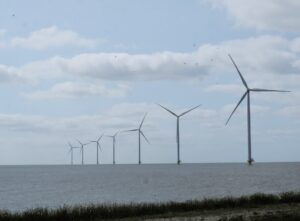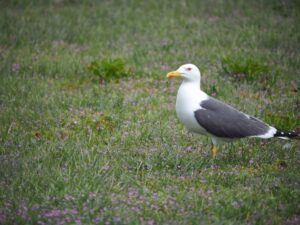Mitigation and management across wind energy and other sectors – Sustainable development in protected areas
Caitlin Cunningham At the PWN purification area at the North Holland Dune Reserve.
Every year, the Alfred Toepfer Natural Heritage Scholarship supports the work of young conservationists in Protected Areas across Europe. Caitlin Cunningham is one of the three Alfred Toepfer Scholarship winners of 2022. In this article, she details the findings of her study visits, where she looked at mitigation and management across wind energy and other sectors.
Article written by Caitlin Cunningham, she works across marine renewable energy at NatureScot – the lead public body responsible for advising Scottish Ministers on all matters relating to the natural heritage.
Mitigation and management across wind energy and other sectors
Sustainable development in protected areas
We are currently in a twin climate and biodiversity crises. Marine renewable energy provides an opportunity to benefit climate change production, whilst simultaneously protecting and minimising impacts to biodiversity.
Across the North Sea, offshore wind is a rapidly expanding industry. Both Scotland and the Netherlands have high ambitions for the expansion of offshore wind energy. Over 45 GW of offshore wind is potentially already in the pipeline in Scottish waters, when including sites that are at the pre-application (prior to consent) stage. Meanwhile, the Netherlands have set an ambitious target of 70 GW of offshore wind by 2050. Dutch offshore wind farms are also at the forefront of biodiversity benefits, with commitments to nature-inclusive design and the development of innovative mitigation measures to protect and enhance biodiversity.
With the support of the Alfred Toepfer Natural Heritage Scholarship, I visited the Netherlands to better understand these novel mitigation techniques, potential compensation measures and examples of nature-inclusive design. I visited three nearshore wind farms – Eemshaven wind farm, Fryslân wind farm and Maasvlakte II wind farm – all located within or nearby protected areas.
Check out the video she created during her visits!
Eemshaven wind farm is adjacent to the Wadden Sea Natura 2000 site. This is a particularly important site for birds, given it is located on a major migration route. Thus, a pilot project is being trialled at Eemshaven wind farm, which involves painting one of the blades of a wind turbine black to assess the effectiveness in reducing the number of collision victims among birds. This follows on from a similar study conducted in Norway, which found a reduction of 70% in the annual collision rate, with the biggest benefits for raptor species. Monitoring is ongoing and the first year of results will be reported later in 2023, with the full project running until September 2024.

Birds flying through the Fryslân wind farm – Caitlin Cunningham
Fryslân wind farm is located within the IJsselmeer Natura 2000 site, adjacent to the Wadden Sea Natura 2000 area and is therefore an important area for many breeding and non-breeding birds, especially waterfowl. Radar is being used at this location, along with regular visual observations by ornithologists, to monitor and validate collision estimates and modelling parameters at the EIA stage. Currently, the radar is not able to identify birds to a species level. In the future, it is hoped that the radar can be trained using the visual observation data to potentially identify more distinctive species. Furthermore, an artificial island was built as a nature reserve, to further benefit biodiversity and help Fryslân wind farm be nature-positive, with the aim to leave lake IJssel in a better condition.
Maasvlakte II wind farm is a coastal development, located adjacent to the Voordelta Natura 2000 site, which is an important area for migratory birds. Nearby, a gull colony in the urbanised Port of Rotterdam area (Europoort to Maasvlakte) is home to approximately 20,000 breeding pairs of lesser black-backed gulls, with a smaller population of herring gulls. To mitigate this collision risk, a radar is being used to continuously track bird movements, with this data then used to automatically shut down turbines as needed.
Additionally, I learnt more about how these approaches are applied at offshore wind farms in the Dutch North Sea, drawing comparisons to offshore wind energy in Scotland. To achieve this, I visited two specialist locations – University of Amsterdam and the Offshore Expertise Centrum (OEC). During my study visit in May 2023, turbines at two Dutch offshore wind farms, Borssele and Egmond aan Zee, were temporarily shut down to help migrating birds pass safely. This is an international first and a positive measure for birds, especially given the global importance of the East-Atlantic flyway for migration, which crosses the North Sea.

Lesser black-backed gull at Maasvlakte – Caitlin Cunningham
I was also interested in lessons learnt from other industries. I visited the Voordelta Natura 2000 site and learnt about the formal fisheries-based compensation associated with the expansion of the Port of Rotterdam in this protected area. The European Commission gave permission for the expansion on the condition that the habitat loss be compensated. However, it has come to light that the compensation has not been effective and other measures must quickly be secured.
To better understand how other industries implement sustainable development in protected areas, I visited a water treatment plant and the North Holland Dune Reserve managed by the water company, Puur Water & Natuur (PWN). As part of the water purification process, water is transported to the dunes on the coast to naturally filter the water. To improve the condition of the reserve, infiltration ponds and dune slacks have been redesigned, to help promote the young successional stages of wet dune slacks. As sea level rise increases, this poses a risk to the drinking water supply through saltwater intrusion. Thus, the drinking water companies have a vested interest to conserve and enhance the dune systems to improve resilience to future threats and preserve the ecosystem services the dunes provide.
The associated report presents the findings of my visit, including recommendations for the offshore wind sector, with a particular focus on relevance to Scotland.